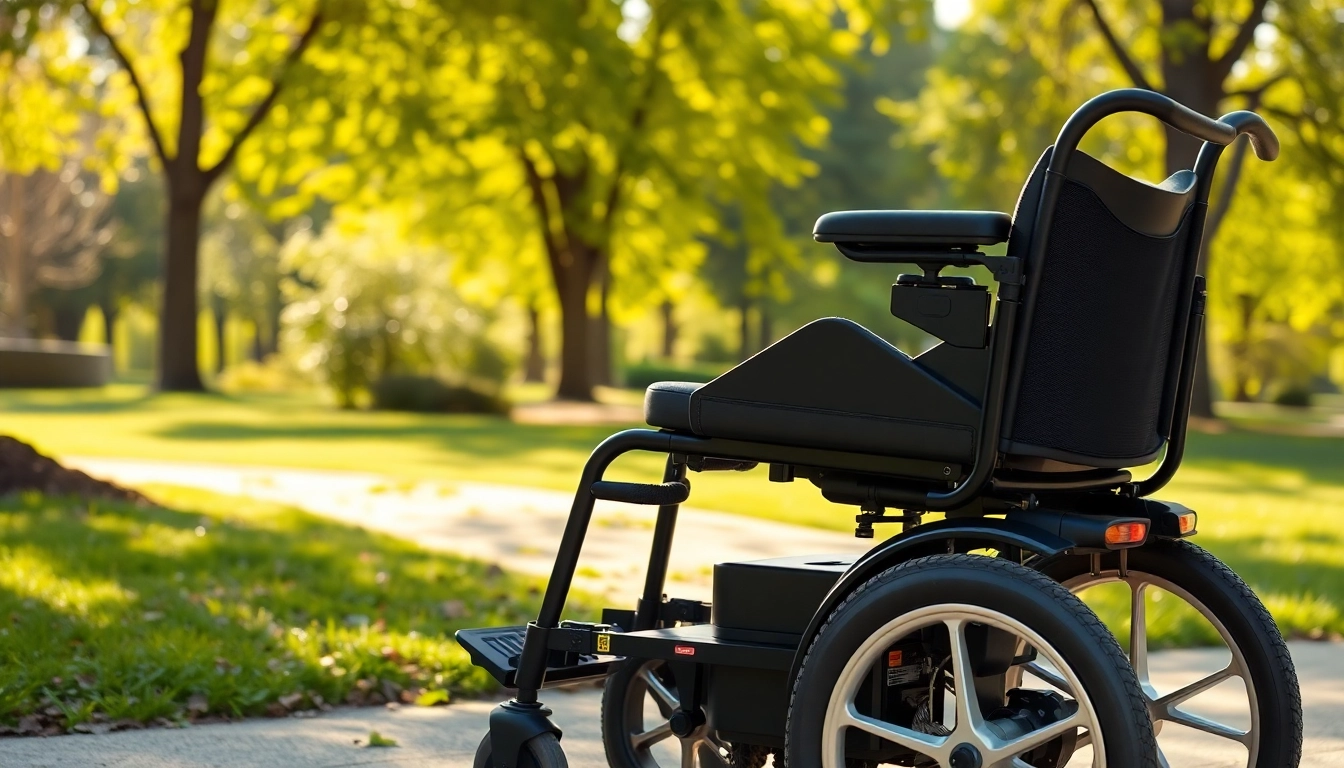Understanding Power Wheelchairs
Power wheelchairs are revolutionary mobility devices designed for individuals who have difficulty with traditional manual wheelchairs. These powered alternatives provide enhanced mobility, independence, and comfort, dramatically improving the quality of life for their users. Designed with advanced technology, power wheelchairs cater to various needs, making them an essential tool for many. To explore various options and features available in the market, consider visiting a dedicated power wheelchair provider today.
What is a Power Wheelchair?
A power wheelchair, often referred to as an electric wheelchair, utilizes a battery-powered system for mobility. Unlike manual wheelchairs, which require physical effort to move, power wheelchairs are steered with a joystick or control panel, allowing individuals to navigate effortlessly. They come equipped with various features tailored to individual needs, including adjustable seating, tilt capabilities, and even specialized controls for those with limited hand function. Power wheelchairs are an excellent choice for people with disabilities, injuries, or conditions that restrict their mobility.
Key Features of Power Wheelchairs
- Motorized Operation: Power wheelchairs are powered by electric motors that provide movement without manual effort. This motorized operation allows users to cover larger distances with ease.
- Customizable Seating Options: Many power wheelchairs offer adjustable seating configurations to optimize comfort and support, accommodating various body types and needs.
- Advanced Maneuverability: Features like tilt and recline options enhance comfort by allowing users to change positions throughout the day, reducing the risk of pressure sores.
- Technology Integration: Modern power wheelchairs often integrate smart technologies, including app connectivity and advanced navigation systems, making them easier to operate and more adaptive to users’ needs.
- Durable Construction: Designed to withstand daily wear and tear, most power wheelchairs feature robust frames and are equipped for both indoor and outdoor use.
Power Wheelchair vs Manual Wheelchair: Which is Right for You?
Choosing between a power and a manual wheelchair often boils down to individual needs, lifestyle, and personal capabilities. Manual wheelchairs require physical effort and are suitable for those with upper body strength and the ability to propel themselves. They are typically lighter, more compact, and easier to transport. Conversely, power wheelchairs offer the independence that comes with motorized mobility, ideal for people who may tire easily or lack sufficient arm and hand strength. Important considerations should include:
- Mobility Level: Assess personal mobility abilities. If significant upper body strength and stamina are present, a manual wheelchair might suffice.
- Daily Activity Level: Consider how often the wheelchair will be used and what terrain it will navigate, as power wheelchairs handle uneven surfaces more effectively.
- Cost Factors: Power wheelchairs tend to be more expensive upfront but may prove cost-effective in the long run due to reduced physical exertion and enhanced independence.
Benefits of Using a Power Wheelchair
Enhanced Mobility and Freedom
One of the most significant advantages of power wheelchairs is the enhanced mobility they offer. Users can travel longer distances without the fatigue that often accompanies manual propulsion. This increased range enables people to participate more fully in everyday activities, including social events, family gatherings, and errands. The ability to maintain independence while navigating their environment provides psychological benefits as well.
Comfort and Ergonomics in Daily Use
Power wheelchairs are designed with user comfort in mind. Features like cushioned seating, ergonomic controls, and customizable configurations minimize discomfort during daily use. Many models also offer suspension systems that absorb shocks and provide a smoother ride over uneven surfaces. This ergonomic focus is critical in preventing common issues such as back pain, pressure sores, and wrist strain, making power wheelchairs a more sustainable long-term mobility solution.
Power Wheelchairs for Specific Needs: A Case Study
A compelling example of a power wheelchair’s impact can be observed in the case of Sarah, a 37-year-old woman diagnosed with multiple sclerosis. Sarah initially used a manual wheelchair but found the physical exertion increasingly taxing due to her condition. Transitioning to a power wheelchair allowed her to regain independence in her daily life. She was able to attend work, go shopping, and visit friends—all activities that became daunting with a manual wheelchair. This shift not only improved her physical mobility but also had a positive effect on her mental health. Her experience illustrates how power wheelchairs can significantly enhance quality of life for individuals with specific mobility challenges.
Choosing the Right Power Wheelchair
Factors to Consider When Selecting a Power Wheelchair
When selecting a power wheelchair, several factors should be taken into account to ensure the chosen model meets personal needs effectively:
- Weight Capacity: Check the weight limit of the wheelchair to ensure it can adequately support the user.
- Size and Portability: Consider both the dimensions of the chair and whether it can be easily transported in a vehicle.
- Battery Life and Range: Evaluate the chair’s battery performance based on daily distance requirements. A longer-lasting battery provides more freedom to travel.
- Customization Options: Look for adjustable seating, armrests, and footrests to enhance comfort.
- Terrain Navigation: If you plan on using the wheelchair outdoors frequently, consider models adept at handling various terrains.
- Budget Constraints: Determine what features are non-negotiable within your budget to avoid overspending.
Top Brands and Models in the Market
Several brands have established themselves as leaders in the power wheelchair market, known for quality and innovation. Here are some top brands to consider:
- Permobil: Renowned for their customizable options and features targeting individual needs, including rehabilitation concerns.
- Pride Mobility: Offers a wide range of models catering to various levels of mobility and price points.
- Invacare: Known for durable construction, this brand provides models designed for both indoor and outdoor use.
- Quantum Rehab: Focuses on advanced technology and customizability, ideal for users who require advanced support features.
Budgeting for Your Power Wheelchair Purchase
Purchasing a power wheelchair requires careful budgeting. Models can range significantly in price, influenced by brand, features, and specifications. Additionally, consider potential insurance coverage; in many cases, power wheelchairs might be partially or fully covered if prescribed by a healthcare professional. To budget transparently:
- Research average costs for different models and determine what fits your financial situation.
- Account for ongoing costs like maintenance, parts replacement, and periodic battery replacement.
- Investigate available grants or local charities that assist with purchasing mobility devices.
Maintaining Your Power Wheelchair
Regular Maintenance Tips for Longevity
To maximize the lifespan of a power wheelchair, regular maintenance is essential. Users should adhere to the following maintenance tips:
- Conduct periodic inspections of the wheels, batteries, and wiring for any signs of wear or damage.
- Keep the wheelchair clean, particularly the undercarriage and wheels, to avoid dirt buildup that can affect performance.
- Check and keep the batteries fully charged to enhance their longevity and ensure optimal functionality.
- Engage a professional for routine inspections and battery replacement as needed.
Common Repairs and When to Seek Help
Even with regular maintenance, power wheelchairs can experience issues. Common repair concerns include:
- Battery Failure: Should the wheelchair not hold a charge, this indicates potential battery failure and requires immediate replacement.
- Motor Issues: If movement is sluggish, this may suggest problems with the motor that require professional attention.
- Control Problems: If the joystick or controls are unresponsive, it’s essential to consult with a technician to diagnose and resolve the issue.
Timely intervention can often preempt more significant problems and expenses down the line.
Upgrading Features for Enhanced Performance
As technology advances and personal needs evolve, upgrading features can enhance a power wheelchair’s performance. Consider exploring:
- Advanced drivetrain systems that improve speed and maneuverability, especially for varied terrains.
- Integration of smart technologies for easier navigation and user interaction.
- Custom seating options that aid in achieving optimal posture and comfort.
Future Innovations in Power Wheelchairs
Trending Technologies in Mobility Solutions
The landscape of power wheelchairs is continuously evolving, with several innovative technologies making their way onto the market. Emerging trends include:
- Smart Sensors: These technologies enable user-friendly features such as obstacle detection, improving safety and navigation.
- Mobile App Integration: Many newer models allow users to monitor battery levels, track usage statistics, and customize settings via mobile applications.
- 3D Printing: This technology is becoming increasingly popular, allowing for customized components and parts tailored to individual user needs.
Impact of AI on Power Wheelchair Designs
Artificial intelligence (AI) is poised to revolutionize power wheelchair design. Key impacts include:
- Adaptive Learning: AI can potentially adapt to individual movement patterns, enhancing maneuverability and responsiveness.
- Enhanced User Interfaces: With AI, control systems for wheelchairs might develop to be far more intuitive, requiring less effort to operate.
- Predictive Maintenance: AI can analyze usage data to forecast maintenance needs, enabling preemptive repairs and reducing downtime.
Consumer Expectations: What’s Next in Power Wheelchairs?
As the market evolves, consumers expect more from power wheelchairs, including:
- Increased customization options that cater to individual preferences and diverse needs.
- Greater affordability, making power wheelchairs available to a more extensive user population.
- Better integration with smart home technologies, allowing seamless interaction between mobility devices and home automation systems.



